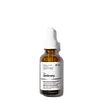What's inside
What's inside
 Key Ingredients
Key Ingredients

 Benefits
Benefits

 Concerns
Concerns

 Ingredients Side-by-side
Ingredients Side-by-side

Water
Skin ConditioningPropanediol
SolventAscorbyl Glucoside
AntioxidantErgothioneine
AntioxidantEpigallocatechin Gallatyl Glucoside
AntioxidantAcetyl Tetrapeptide-2
Skin ConditioningHeptapeptide-6
Skin ConditioningTocotrienols
Skin ConditioningTremella Fuciformis Sporocarp Extract
AntioxidantSphingomonas Ferment Extract
Skin ConditioningPanax Ginseng Root Extract
EmollientBixa Orellana Seed Extract
MaskingGlycerin
HumectantIsoceteth-20
EmulsifyingCitric Acid
BufferingSodium Citrate
BufferingSodium Hydroxide
BufferingCaprylyl Glycol
EmollientEthylhexylglycerin
Skin ConditioningPhenoxyethanol
PreservativeChlorphenesin
AntimicrobialWater, Propanediol, Ascorbyl Glucoside, Ergothioneine, Epigallocatechin Gallatyl Glucoside, Acetyl Tetrapeptide-2, Heptapeptide-6, Tocotrienols, Tremella Fuciformis Sporocarp Extract, Sphingomonas Ferment Extract, Panax Ginseng Root Extract, Bixa Orellana Seed Extract, Glycerin, Isoceteth-20, Citric Acid, Sodium Citrate, Sodium Hydroxide, Caprylyl Glycol, Ethylhexylglycerin, Phenoxyethanol, Chlorphenesin
Water
Skin ConditioningAscorbyl Glucoside 10%
AntioxidantGlycerin
HumectantSalix Nigra Bark Extract
Skin ProtectingSodium Hydroxide
BufferingSodium Levulinate
Skin ConditioningHaematococcus Pluvialis Extract
AntioxidantSodium Hyaluronate
HumectantSimmondsia Chinensis Seed Oil
EmollientAstragalus Gummifer Gum
Emulsion StabilisingLevulinic Acid
PerfumingSodium Anisate
AntimicrobialPhytic Acid
Polyepsilon-Lysine
Skin ConditioningTocopherol
AntioxidantHelianthus Annuus Seed Oil
EmollientWater, Ascorbyl Glucoside 10%, Glycerin, Salix Nigra Bark Extract, Sodium Hydroxide, Sodium Levulinate, Haematococcus Pluvialis Extract, Sodium Hyaluronate, Simmondsia Chinensis Seed Oil, Astragalus Gummifer Gum, Levulinic Acid, Sodium Anisate, Phytic Acid, Polyepsilon-Lysine, Tocopherol, Helianthus Annuus Seed Oil
 Reviews
Reviews

Ingredients Explained
These ingredients are found in both products.
Ingredients higher up in an ingredient list are typically present in a larger amount.
Ascorbyl Glucoside is a stable form of Vitamin C. It is created by combining glucose from starch.
When applied to skin, Ascorbyl Glucoside turns into Ascorbic Acid.
Ascorbyl Glucoside is an antioxidant. Antioxidants help fight free-radicals, or molecules that may damage skin cells.
It can help to reduce redness, improve skin texture, reduce the effects of aging, reduce the visibility of dark spots, and brighten skin.
Read more about other types of Vitamin C:
Learn more about Ascorbyl GlucosideGlycerin is already naturally found in your skin. It helps moisturize and protect your skin.
A study from 2016 found glycerin to be more effective as a humectant than AHAs and hyaluronic acid.
As a humectant, it helps the skin stay hydrated by pulling moisture to your skin. The low molecular weight of glycerin allows it to pull moisture into the deeper layers of your skin.
Hydrated skin improves your skin barrier; Your skin barrier helps protect against irritants and bacteria.
Glycerin has also been found to have antimicrobial and antiviral properties. Due to these properties, glycerin is often used in wound and burn treatments.
In cosmetics, glycerin is usually derived from plants such as soybean or palm. However, it can also be sourced from animals, such as tallow or animal fat.
This ingredient is organic, colorless, odorless, and non-toxic.
Glycerin is the name for this ingredient in American English. British English uses Glycerol/Glycerine.
Learn more about GlycerinSodium Hydroxide is also known as lye or caustic soda. It is used to adjust the pH of products; many ingredients require a specific pH to be effective.
In small amounts, sodium hydroxide is considered safe to use. However, large amounts may cause chemical burns due to its high alkaline.
Your skin has a natural pH and acid mantle. This acid mantle helps prevent harmful bacteria from breaking through. The acid mantle also helps keep your skin hydrated.
"Alkaline" refers to a high pH level. A low pH level would be considered acidic.
Learn more about Sodium HydroxideWater. It's the most common cosmetic ingredient of all. You'll usually see it at the top of ingredient lists, meaning that it makes up the largest part of the product.
So why is it so popular? Water most often acts as a solvent - this means that it helps dissolve other ingredients into the formulation.
You'll also recognize water as that liquid we all need to stay alive. If you see this, drink a glass of water. Stay hydrated!
Learn more about Water